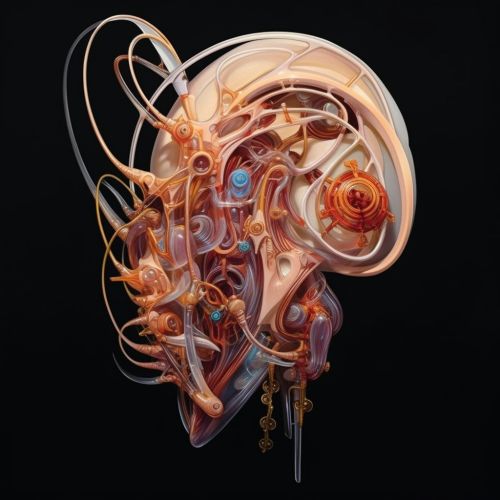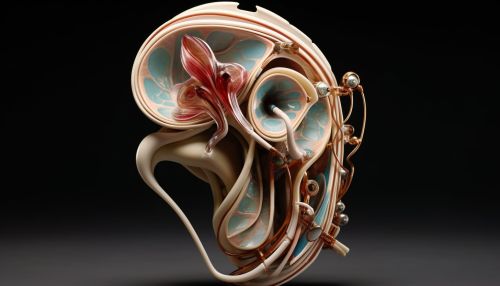Middle ear
Anatomy of the Middle Ear
The middle ear is an air-filled, membrane-lined cavity situated within the temporal bone of the skull. It is located between the external ear and the inner ear, serving as a critical component in the human auditory system. The middle ear's primary function is to transmit sound from the external ear to the inner ear, a process that involves the transformation of airborne sound waves into mechanical vibrations and subsequently into fluid-borne waves in the inner ear.


The middle ear is composed of several key structures: the tympanic membrane (or eardrum), the ossicles (a chain of three tiny bones), and the eustachian tube. Each of these components plays a vital role in the transmission and amplification of sound.
Tympanic Membrane
The tympanic membrane, commonly known as the eardrum, is a thin, semi-transparent membrane that separates the external ear from the middle ear. It is responsible for the initial reception of sound waves, which it accomplishes by vibrating in response to these waves. The tympanic membrane's shape and tension are crucial for its function, as they determine its natural frequency of vibration and thus its sensitivity to different sound frequencies.
Ossicles
The ossicles are a chain of three tiny bones located within the middle ear, named the malleus (hammer), incus (anvil), and stapes (stirrup) for their distinctive shapes. These bones are among the smallest in the human body and serve to transmit and amplify the vibrations from the tympanic membrane to the inner ear. The malleus is attached to the tympanic membrane, and the stapes is connected to the oval window of the inner ear. The incus is located between them, articulating with both other bones.
Eustachian Tube
The eustachian tube, also known as the auditory tube, is a narrow passage that connects the middle ear to the nasopharynx, the upper part of the throat behind the nose. Its primary function is to equalize the air pressure in the middle ear with the external atmospheric pressure, which is essential for the optimal performance of the tympanic membrane. The eustachian tube also facilitates the drainage of normal and pathological secretions from the middle ear.
Physiology of the Middle Ear
The middle ear's primary role is in the conduction and amplification of sound. Sound waves entering the external ear strike the tympanic membrane, causing it to vibrate. These vibrations are then transferred to the ossicles. The ossicles amplify the sound vibrations and transmit them to the oval window, a membrane-covered opening to the inner ear. The amplified vibrations cause the fluid in the inner ear to move, stimulating the sensory cells of the cochlea, the organ of hearing. This process converts the mechanical sound vibrations into electrical signals that can be interpreted by the brain.
The middle ear also plays a role in protecting the inner ear from excessively loud noises. This is achieved through the action of two small muscles, the tensor tympani and the stapedius, which are attached to the ossicles. When these muscles contract in response to high-intensity sound, they stiffen the ossicles, reducing their ability to transmit sound and thus dampening the sound's intensity before it reaches the inner ear.
Pathology of the Middle Ear
Various diseases and conditions can affect the middle ear, impacting its function and potentially leading to hearing loss. These include otitis media, otosclerosis, cholesteatoma, and barotrauma.
Otitis Media
Otitis media is an inflammation of the middle ear, often associated with a buildup of fluid. It can be caused by bacterial or viral infections, allergies, or dysfunction of the eustachian tube. Symptoms may include ear pain, fever, and hearing loss. Chronic otitis media can lead to serious complications, such as perforation of the tympanic membrane or the development of a cholesteatoma.
Otosclerosis
Otosclerosis is a condition characterized by abnormal bone growth in the middle ear, particularly around the stapes. This can result in the stapes becoming fixed, or ankylosed, reducing its ability to vibrate and thus impairing the transmission of sound to the inner ear. Otosclerosis is a common cause of conductive hearing loss in adults.
Cholesteatoma
A cholesteatoma is a benign growth of skin cells in the middle ear, often resulting from chronic otitis media. Cholesteatomas can gradually expand and erode the surrounding structures, including the ossicles and the temporal bone, leading to hearing loss and potentially life-threatening complications such as meningitis or brain abscess.
Barotrauma
Barotrauma of the ear is a condition caused by a rapid change in air pressure, which can occur during activities such as flying or diving. This can lead to a differential pressure across the tympanic membrane, causing pain and potentially leading to damage such as a perforated eardrum.
